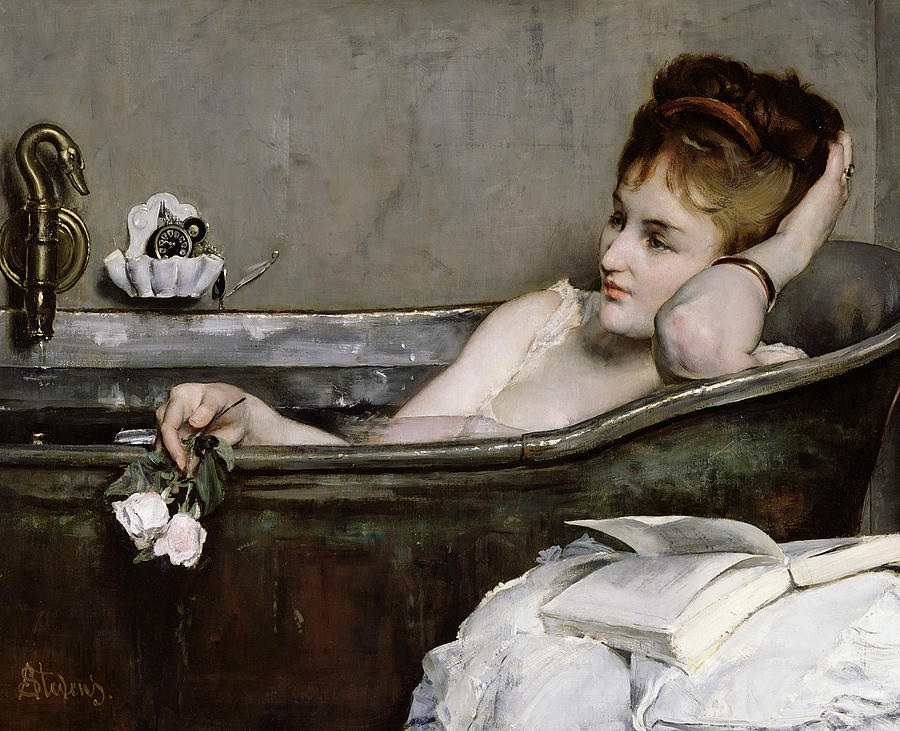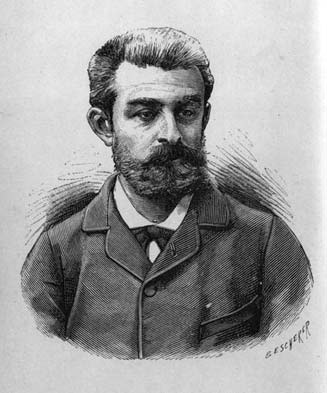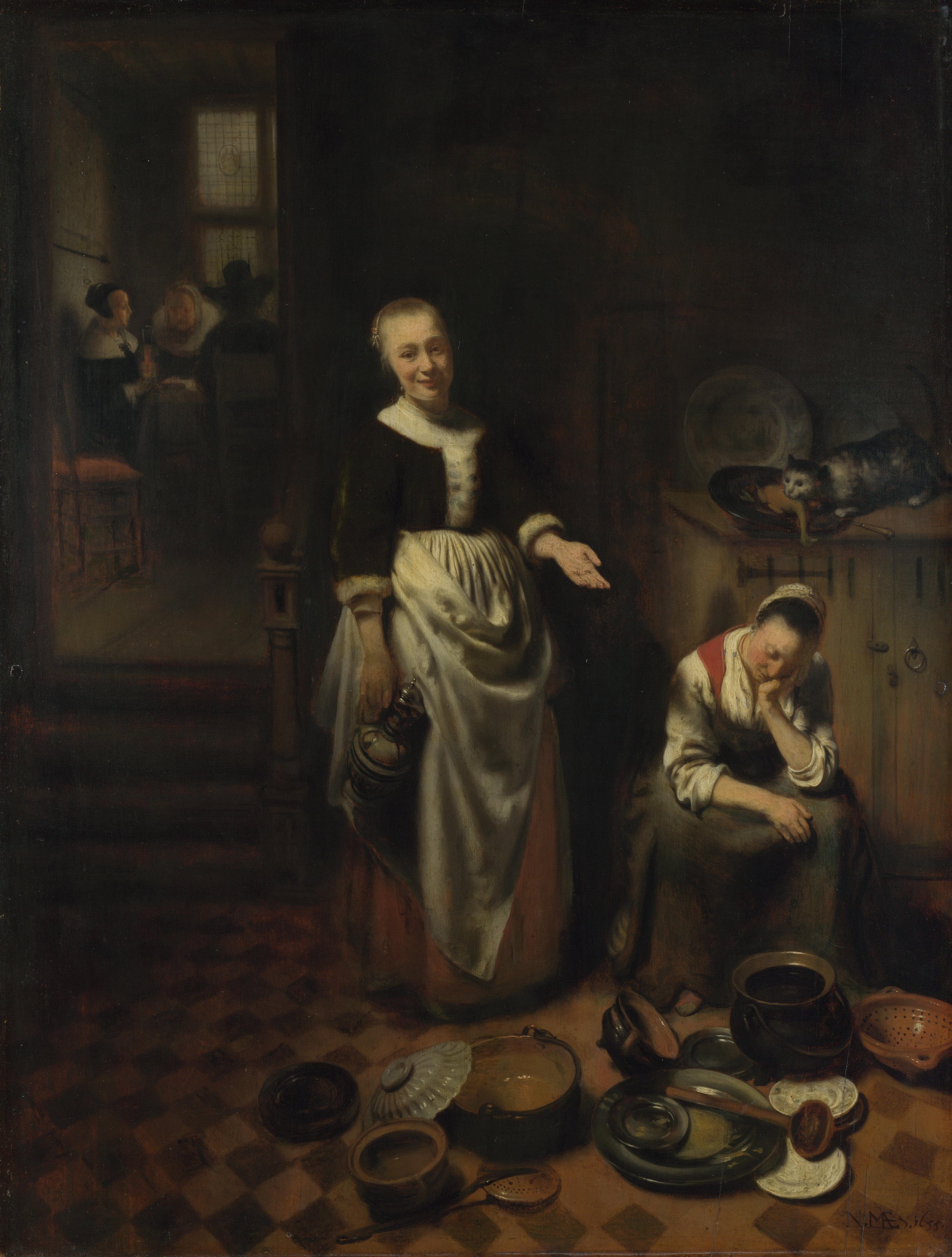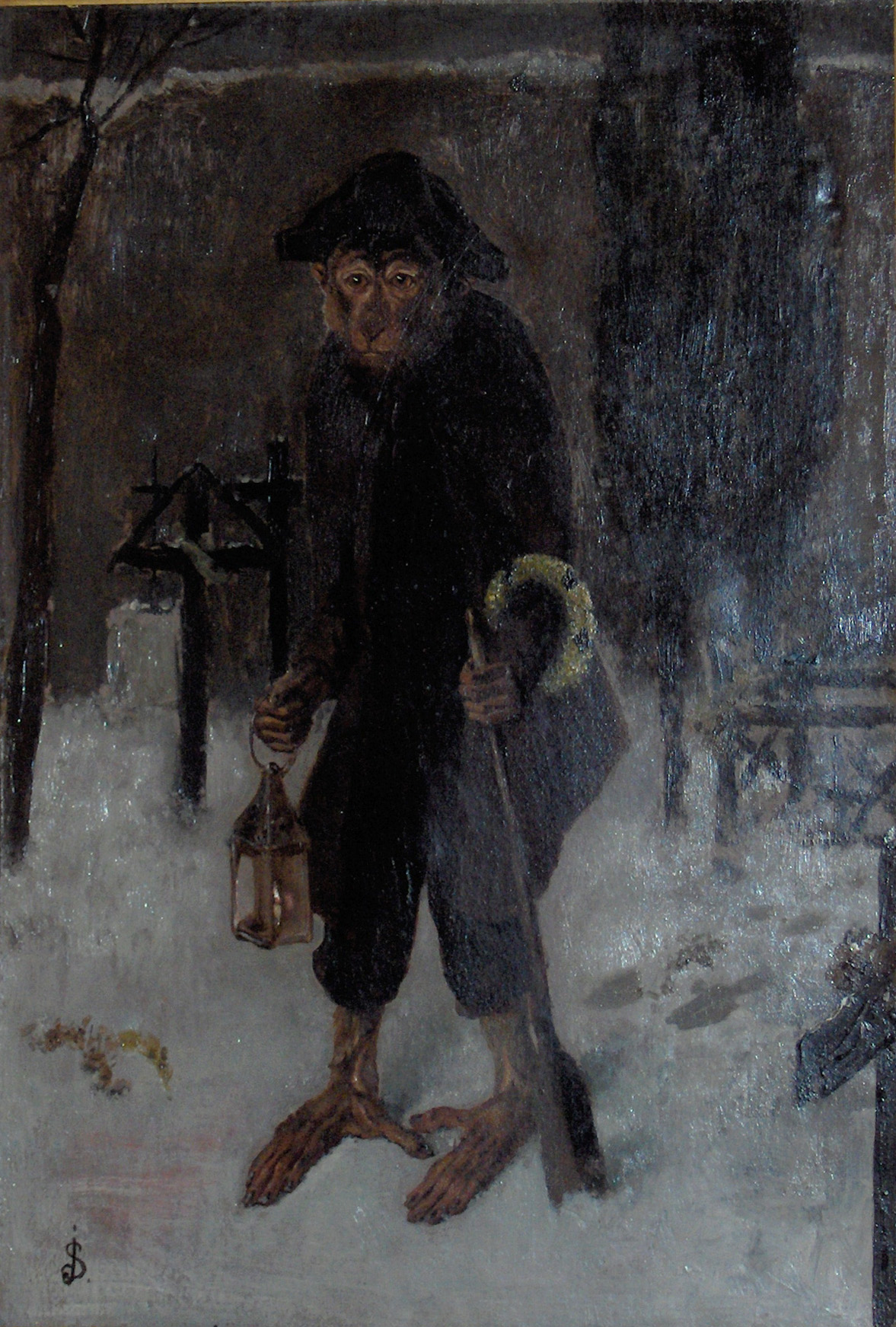|
The Parisian Sphinx
''The Parisian Sphinx'' is an oil-on-canvas painting by Belgian painter Alfred Stevens. Painted between 1875 and 1877, it depicts a dreamy young woman (or aristocratic ''demi-monde'') gently supporting her head with her hand. The painting is part of the permanent collection of the Royal Museum of Fine Arts in Antwerp. The ''Parisian Sphinx'' shows the influence of Vermeer and the other Netherlandish old masters on Stevens, and testifies to the Symbolist influence in the latter's day. It incorporates a harmonious juxtaposition of superficial Dutch realism with the spreading Symbolist manner, as opposed to the bottom-up, pluralistic symbolism of the declining Romanticism. Beside being renowned for its realism and luminism, ''The Parisian Sphinx'' has been described as ''enigmatic''. Critics agree in that the apparently realistic painting conceals a hidden meaning. Many point to the "hidden dangers behind feminine tenderness", and to the figure of the ''femme fatale''. Backgroun ... [...More Info...] [...Related Items...] OR: [Wikipedia] [Google] [Baidu] |
Alfred Stevens (painter)
Alfred Émile Léopold Stevens (11 May 182324 August 1906) was a Belgian painter, known for his paintings of elegant modern women. In their realistic style and careful finish, his works reveal the influence of 17th-century Dutch genre painting. After gaining attention early in his career with a social realist painting depicting the plight of poor vagrants, he achieved great critical and popular success with his scenes of upper-middle class Parisian life. He tended to use the same models over and over again, and not all of them were aristocratic. "At least three of his frequent models can be identified in the infamous Book of the Courtesans, a top secret leather bound book containing the surveillance files of the Paris vice squad," writes author SummeBrennan Family background Stevens was born in Brussels. He came from a family involved with the visual arts: his older brother Joseph (1816–1892) and his son Léopold (1866–1935) were painters, while another brother Arthur (1825� ... [...More Info...] [...Related Items...] OR: [Wikipedia] [Google] [Baidu] |
Liévin De Winne
Liévin De Winne (Ghent, 24 January 1821 - Brussels, 13 May 1880) was a Belgian portrait painter who painted the official portrait of Leopold I of Belgium, Leopold I on which the first postage stamp of Belgium was based. De Winne was a pupil of Félix De Vigne and Henri van der Haert at the Royal Academy of Fine Arts (Ghent), Royal Academy of Fine Arts of Ghent. In 1850 he received a grant from the government of Belgium that enabled him to travel to Paris and from 1852 to 1855 he was able to share a studio with Jules Breton who subsequently wrote De Winne's biography. From 1861, De Winne resumed residency in Belgium where he established himself as a portrait painter to high society. His direct and insightful style won him many eminent clients and was a decisive break with the more romantic style of earlier Belgian portrait painting."De Winne, Liévin" by Alain Jacobs in ''Grove Art Online'', oxfordartonline.com, Oxford University Press. Retrieved 4 March 2014. Selected works *'' ... [...More Info...] [...Related Items...] OR: [Wikipedia] [Google] [Baidu] |
Baudelaire
Charles Pierre Baudelaire (, ; ; 9 April 1821 – 31 August 1867) was a French poet who also produced notable work as an essayist and art critic. His poems exhibit mastery in the handling of rhyme and rhythm, contain an exoticism inherited from Romantics, but are based on observations of real life. His most famous work, a book of lyric poetry titled ''Les Fleurs du mal'' (''The Flowers of Evil''), expresses the changing nature of beauty in the rapidly industrializing Paris during the mid-19th century. Baudelaire's highly original style of prose-poetry influenced a whole generation of poets including Paul Verlaine, Arthur Rimbaud and Stéphane Mallarmé, among many others. He is credited with coining the term modernity (''modernité'') to designate the fleeting, ephemeral experience of life in an urban metropolis, and the responsibility of artistic expression to capture that experience. Marshall Berman has credited Baudelaire as being the first Modernist. Early life Baudelaire ... [...More Info...] [...Related Items...] OR: [Wikipedia] [Google] [Baidu] |
Oedipus And The Sphinx
''Oedipus and the Sphinx'' is an 1864 oil on canvas painting by Gustave Moreau that was first exhibited at the French Salon of 1864 where it was an immediate success. It is now in the Metropolitan Museum of Art. The work was a fresh treatment of the established subject of the meeting between Oedipus and the Sphinx on the road outside Thebes, as described in Sophocles's play ''Oedipus Rex''. Subject matter The painting depicts Oedipus meeting the Sphinx at the crossroads on his journey between Thebes and Delphi. Oedipus must answer the Sphinx's riddle correctly in order to pass. Failure means his own death and that of the besieged Thebans. The riddle was: "What walks on four feet in the morning, two in the afternoon and three at night?". Oedipus answered: "Man: as an infant, he crawls on all fours; as an adult, he walks on two legs and; in old age, he uses a walking stick". Oedipus was the first to answer the riddle correctly and, having heard Oedipus' answer, the Sphinx was ... [...More Info...] [...Related Items...] OR: [Wikipedia] [Google] [Baidu] |
Gustave Moreau
Gustave Moreau (; 6 April 1826 – 18 April 1898) was a French artist and an important figure in the Symbolist movement. Jean Cassou called him "the Symbolist painter par excellence".Cassou, Jean. 1979. ''The Concise Encyclopedia of Symbolism.'' Chartwell Books, Inc., Secaucus, New Jersey, 292 pp. He was an influential forerunner of symbolism in the visual arts in the 1860s, and at the height of the symbolist movement in the 1890s, he was among the most significant painters. Art historian Robert Delevoy wrote that Moreau "brought symbolist polyvalence to its highest point in ''Jupiter and Semele''."Delevoy, Robert L. 1978. ''Symbolist and Symbolism.'' Editions D'Art Albert Skira, Geneva//Rizzoli International Publishing, Inc. New York. 247 pp. He was a prolific artist who produced over 15,000 paintings, watercolors, and drawings. Moreau painted allegories and traditional biblical and mythological subjects favored by the fine art academies. J. K. Huysmans wrote, "Gustave Moreau ... [...More Info...] [...Related Items...] OR: [Wikipedia] [Google] [Baidu] |
Joris-Karl Huysmans
Charles-Marie-Georges Huysmans (, ; 5 February 1848 – 12 May 1907) was a French novelist and art critic who published his works as Joris-Karl Huysmans (, variably abbreviated as J. K. or J.-K.). He is most famous for the novel ''À rebours'' (1884, published in English as ''Against the Grain'' and as ''Against Nature''). He supported himself by way of a 30-year career in the French civil service. Huysmans's work is considered remarkable for its idiosyncratic use of the French language, large vocabulary, descriptions, satirical wit and far-ranging erudition. First considered part of Naturalism, he became associated with the decadent movement with his publication of ''À rebours.'' His work expressed his deep pessimism, which had led him to the philosophy of Arthur Schopenhauer. In later years, his novels reflected his study of Catholicism, religious conversion, and becoming an oblate. He discussed the iconography of Christian architecture at length in '' La cathédral ... [...More Info...] [...Related Items...] OR: [Wikipedia] [Google] [Baidu] |
Franz Xaver Winterhalter
Franz Xaver Winterhalter (20 April 1805 – 8 July 1873) was a German painter and lithographer, known for his flattering portraits of royalty and upper-class society in the mid-19th century. His name has become associated with fashionable court portraiture. Among his best known works are '' Empress Eugénie Surrounded by her Ladies in Waiting'' (1855) and the portraits he made of Empress Elisabeth of Austria (1865). Early years Franz Xaver Winterhalter was born in the small village of Menzenschwand (now part of Sankt Blasien), in Germany's Black Forest in the Electorate of Baden, on 20 April 1805.Ormond & Blackett-Ord, ''Franz Xaver Winterhalter and the Courts of Europe'', p. 18. He was the sixth child of Fidel Winterhalter (1773–1863), a farmer and resin producer in the village, and his wife Eva Meyer (1765–1838), a member of a long established Menzenschwand family. His father was of peasant stock and was a powerful influence in his life. Of the eight brothers and sisters, ... [...More Info...] [...Related Items...] OR: [Wikipedia] [Google] [Baidu] |
Demi-mondaine
is French for "half-world". The term derives from a play called , by Alexandre Dumas fils, Alexandre Dumas , published in 1855. The play dealt with the way that prostitution at that time threatened the institution of marriage. The was the world occupied by elite men and the women who entertained them and whom they kept, the pleasure-loving and dangerous world Dumas immortalized in the 1848 novel and its many adaptations. Demimondaine became a synonym for a courtesan or a prostitute who moved in these circles—or for a woman of social standing with the power to thumb her nose at convention and throw herself into the hedonistic nightlife. A woman who made that choice would soon find her social status lost, as she became . The 1958 film ''Gigi (1958 film), Gigi'', based on a Gigi (novella), 1944 novella by Colette, vividly portrays the world of the demimonde near the end of its existence. Gigi's Aunt Alicia, a legendary courtesan now enjoying a wealthy retirement, trains her teena ... [...More Info...] [...Related Items...] OR: [Wikipedia] [Google] [Baidu] |
Genre Art
Genre art is the pictorial representation in any of various media of scenes or events from everyday life, such as markets, domestic settings, interiors, parties, inn scenes, work, and street scenes. Such representations (also called genre works, genre scenes, or genre views) may be realistic, imagined, or romanticized by the artist. Some variations of the term ''genre art'' specify the medium or type of visual work, as in ''genre painting'', ''genre prints'', ''genre photographs'', and so on. The following concentrates on painting, but genre motifs were also extremely popular in many forms of the decorative arts, especially from the Rococo of the early 18th century onwards. Single figures or small groups decorated a huge variety of objects such as porcelain, furniture, wallpaper, and textiles. Genre painting ''Genre painting'', also called ''genre scene'' or ''petit genre'', depicts aspects of everyday life by portraying ordinary people engaged in common activities. One comm ... [...More Info...] [...Related Items...] OR: [Wikipedia] [Google] [Baidu] |
Joseph Stevens (painter)
Joseph Édouard Stevens (26 November 1816 – 2 August 1892) was a Belgian animalier painter and engraver. Life He was the son of Jean François Léopold Stevens (1791–1837), a Brussels art dealer and collector, and the elder brother of the painter Alfred Stevens and of the art critic Arthur Stevens (1825 – 1890). He frequented as a dilettante the Académie Royale des Beaux-Arts and followed courses by Louis Robbe and Eugène Verboeckhoven. Partly self-taught, he finished his training in Paris, without enrolling in a school, and frequented the studio of Alexandre-Gabriel Decamps, as well as painters of the Barbizon School and of the "Groupe du Restaurant du Havre" including Thomas Couture, Eugène Isabey, Théodore Rousseau and others. He exhibited at the Brussels Salon from 1842. In 1852 he joined his two brothers in Paris where he lived for several years, dividing his time between the worldliness of the Imperial Court, in particular the Jardin des Tuil ... [...More Info...] [...Related Items...] OR: [Wikipedia] [Google] [Baidu] |
Paris
Paris () is the capital and most populous city of France, with an estimated population of 2,165,423 residents in 2019 in an area of more than 105 km² (41 sq mi), making it the 30th most densely populated city in the world in 2020. Since the 17th century, Paris has been one of the world's major centres of finance, diplomacy, commerce, fashion, gastronomy, and science. For its leading role in the arts and sciences, as well as its very early system of street lighting, in the 19th century it became known as "the City of Light". Like London, prior to the Second World War, it was also sometimes called the capital of the world. The City of Paris is the centre of the Île-de-France region, or Paris Region, with an estimated population of 12,262,544 in 2019, or about 19% of the population of France, making the region France's primate city. The Paris Region had a GDP of €739 billion ($743 billion) in 2019, which is the highest in Europe. According to the Economist Intelli ... [...More Info...] [...Related Items...] OR: [Wikipedia] [Google] [Baidu] |
Camille Roqueplan
Camille Joseph Etienne Roqueplan (18 February 1802/03, Mallemort - 29 September 1855, Paris) was a French Romantic painter of landscapes, genre and historical scenes. Biography From an early age, he displayed an aptitude for drawing, and would often correct his classmates. Around the age of eighteen, he began to take painting lessons. Oddly enough, when his father encouraged him to take up art as a profession, Camille hesitated because he wanted it to remain a pleasant pastime, not become a job. Soon, the lessons he felt forced to take caused him disgust and he took up the study of medicine. He got as far as the anatomy classes, which he found unappealing, and failed the examination. He then became a clerk in the Ministry of Finance, where his father worked, but this was also short-lived. He decided to return to painting, studying landscape and figure drawing with some local artists. Following their advice, he found a position in the studios of Abel de Pujol at the École de ... [...More Info...] [...Related Items...] OR: [Wikipedia] [Google] [Baidu] |










